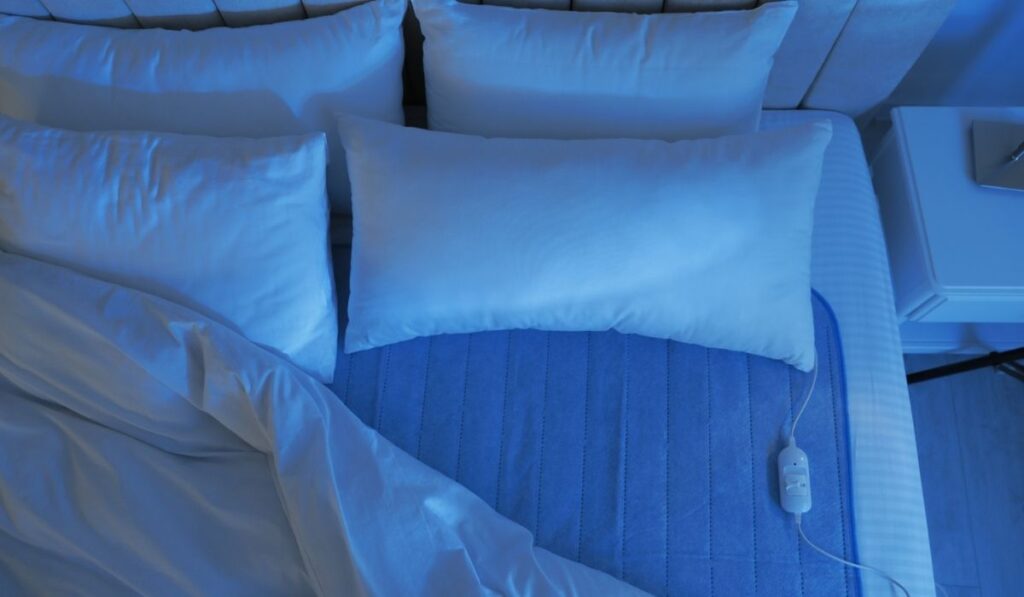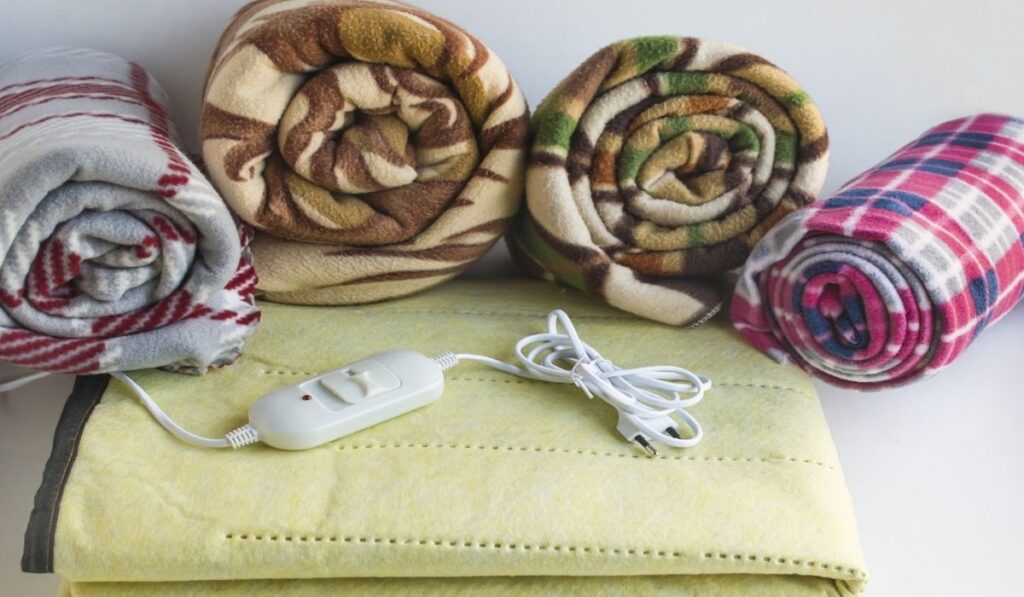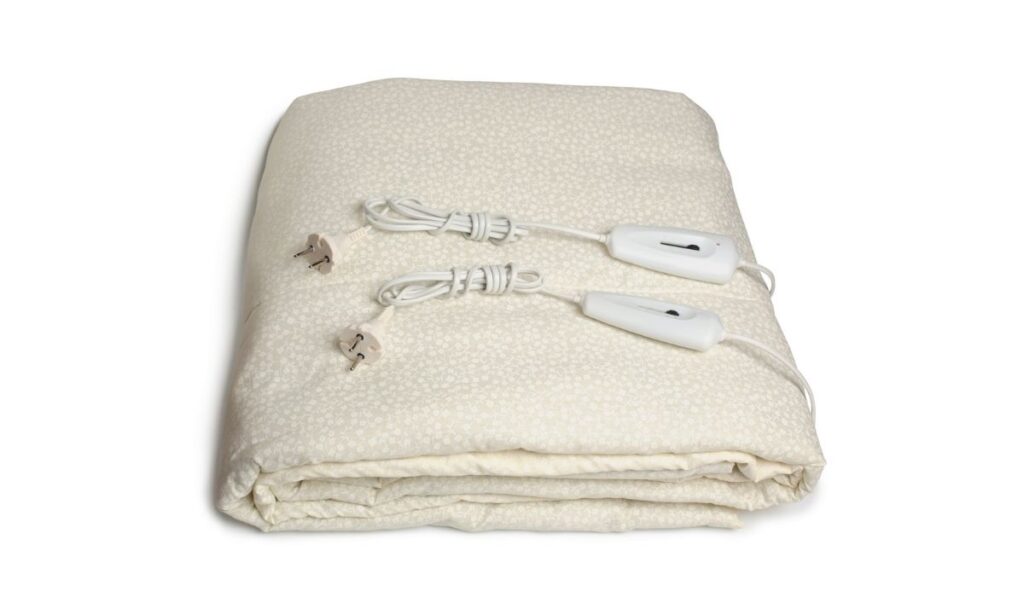An electric blanket can be your best friend on cold winter days, and it may be tempting to sleep on top of the blanket for maximum warmth. But is it safe to sleep on top of an electric blanket?
You can sleep on top of an electric blanket as long as it’s an “under blanket.” Place the blanket underneath the mattress pad to heat the bed uniformly. However, if you have an electric “over blanket,” avoid sleeping on top of it to prevent damage or overheating.
Sleeping on top of an electric over blanket can cause harm to the device and the user. Always follow the proper safety guidelines to avoid electric blanket risks. Let’s look at why electric blankets are so popular, how to choose between the different types, and how to stay safe while using one.
Can You Sleep With an Electric Blanket Under You?

You can sleep on top of some electric blankets without concern. However, some electric blankets aren’t designed to handle the weight and will get damaged if you sleep on top of them.
Always check whether the blanket is designed for use under or over the covers. Never sleep on top of an over blanket or under an under blanket.
If you sleep on top of an electric blanket that’s not designed for “under” use, your weight may damage or displace the electric wires. This increases the risk of fires, electric shocks, and burns. It may also cause the blanket’s fabric to wear off more quickly, resulting in dangerous exposed wires.
Sleeping on top of electric blankets that don’t have automatic temperature control or emergency shutoff settings may also result in overheating. At the very least, you’ll have to worry about a damaged blanket. The worst that can happen is your house burning down!
What Are Electric Overblankets?
Electric over blankets take the form of regular blankets with electric heating cords inside them. They’re the most common electric blanket and are designed to use over the covers. The blanket heats the covers underneath and prevents warmth from escaping.
Electric over blankets, like the WOOMER Heated Throw Blanket (on Amazon), are usually thicker than under blankets or mattress pads, and the wires are less stable. These blankets are safe and carry very little risk of fires or burns if used correctly. However, if you sleep on an over blanket, the wires may get damaged, resulting in potential burns, fires, or even electric shocks.
The latest electric over blankets have heat control settings designed to prevent overheating. Some of these blankets have a timer that switches the blanket off automatically after it heats up, so you don’t damage it when sleeping.
Electric over blankets are washable but require careful care while handling them to avoid damaging the wires. The wiring is more flexible in blankets but can still easily be damaged under weight.
What Are Electric Underblankets?
Electric under blankets are designed to be used under the covers and mattress, like this heated mattress pad from CURECURE (on Amazon). With these blankets, the heat travels upwards, warming the layers of bedding. Electric under blankets are thinner than over blankets and should be placed under the mattress pad. They also produce more heat since the warmth needs to make its way through all the layers of bedding.
Electric blankets placed under mattresses often have better heat control settings and can be used for longer than over blankets. They are also more durable, and the wires don’t damage easily with weight. However, these blankets shouldn’t be folded to avoid wire damage.
Thinner electric under blankets can be placed on top of a mattress pad. However, you’ll still need to place a sheet over the blanket before sleeping on top of it for safety reasons. Placing an electric under blanket between the bedding and mattress pad helps protect the wires and reduces the risk of short circuits.
Some electric mattress pads are much thicker than regular blankets and can take the place of your mattress. Older “under” electric mattress pads don’t have many safety features, but newer ones have the same temperature control safety features as electric over blankets.
Which Type of Electric Blanket Is Better?

While there’s no harm in sleeping with both an over blanket and an under blanket if they have temperature control settings, one electric blanket is usually enough to keep you warm. So, which one is better in terms of heating and safety?
Let’s look at the pros and cons of both blankets first:
Benefits of Electric Overblankets
- Easily Available
Electric over blankets are the most common type of electric blankets and are easily available in most bedding stores or online. They are also slightly cheaper than under blankets.
- More Flexible
The wires over blankets won’t damage easily since they are more flexible than under blankets. These blankets are designed for machine washing and are easy to store. The flexibility of electric over blankets makes it easy to move around without damaging the wires.
- Provides Natural Heat
Over blankets are used as covers and trap the natural heat inside the bedding. This reduces the risk of overheating and keeps you comfortably warm in the winter. The heat of over-electric blankets may also be beneficial to your health.
Benefits of Electric Underblankets
- More Stability
Underblankets are placed in a fixed position and won’t move around when you’re sleeping. This gives the bed more uniform heat and protects the wiring against damage.
- Less Heat Loss
The extra layers of bedding on top of under blankets prevent heat loss, making them more energy-efficient. The layers of bedding also trap more heat inside the bed.
- More Safety
Electric under blankets can handle more weight, and the wires won’t get damaged easily. This makes it safer to sleep on top of a heated mattress pad. Most electric under blankets also have temperature control features that prevent the mattress from overheating.
Disadvantages of Electric Overblankets
- Less Efficient
Electric over blankets have more heat loss since the top half of the blanket is exposed to the air. This reduces their heating efficiency.
- Higher Risk of Overheating
While the blanket may have temperature control systems, it’s easy to get too hot under an electric over blanket. The heat is trapped under the covers, increasing the risk of sweating or developing a heat stroke in extreme cases.
- Can Feel Heavy
Overblankets are heavier than under blankets and can be stifling. This makes it quite uncomfortable and may disrupt your sleep.
Disadvantages of Under Electric Blankets
- Not as Flexible
Electric under blankets need to be the exact size as the mattress. They are also more difficult to move, and you’ll have to shift the mattresses when using them on different beds.
- May Cause Night Sweats
Underblankets can become quite hot due to the layers of bedding on top of them. This may make it uncomfortable and cause night sweats. However, if you have one with automatic temperature sensors, you shouldn’t have this problem.
So, which electric blanket is best to use? If you want something stable that doesn’t need regular washing, an under blanket is better. You can also sleep on top of it without damaging the wires. However, if you want something flexible that you can move between rooms, and over blanket is better.
Can You Put Anything On Top of an Electric Blanket?

Never place anything on top of an electric blanket while it’s on. While blankets are designed to handle the weight, irregular objects such as books, toys, and other household objects may damage the wiring. It would help if you didn’t put anything on top of electric over blankets, even when off, as this may cause overheating.
Placing objects on top of an electric blanket also blocks the heat from escaping, potentially causing overheating and increasing the risk of fires. There is more risk if the blanket is older or the material is flammable.
Should an Electric Blanket Go Over or Under a Mattress Pad?
Overblankets should always go over the mattress pad. Underblankets are usually placed under the mattress pad. However, if the heating is insufficient when you place it under the mattress pad, you can place it over the mattress pad but under a mattress topper.
There’s no harm in placing an electric under blanket on top of the mattress. However, there should still be enough space between you and the blanket, so either place sheets or a mattress topper on top of the electric blanket for safety.
Sleeping directly on top of an electric blanket is never a good idea as it may cause burns or even shocks if the blanket is damaged.
What Are Some Tips to Stay Safe If You Use an Electric Blanket?
The risks of using an electric blanket aren’t high if you use it properly. However, you can minimize these risks by following the correct usage instructions. Here are some safety tips to keep in mind when using an electric blanket:
- Avoid Folding the Blanket
Folding an electric blanket can cause the wires to get damaged. This may result in short circuits, overheating, or even fires. Always roll the blanket when storing it to avoid damaging the heating element.
- Never Use a Wet Electric Blanket
As with all-electric appliances, never use an electric blanket that’s wet. The best electric blankets are designed with safety switches that turn the blanket off when wet. However, there’s still the risk of getting an electric shock.
- Don’t Use Old Blankets.
Old electric blankets are disasters waiting to happen. They lack crucial safety features and overheat easily, so you should avoid them at all costs. The same goes for second-hand blankets.
- Don’t Iron Electric Blankets.
Most blankets have fabric that shouldn’t be ironed. You’ll have to take extra care not to iron an electric blanket as it may damage the cord insulation.
- Set a Time Limit for Heating
If your blanket has an automatic timer, set it for around half an hour. Otherwise, switch the blanket off manually after the time limit is reached.
